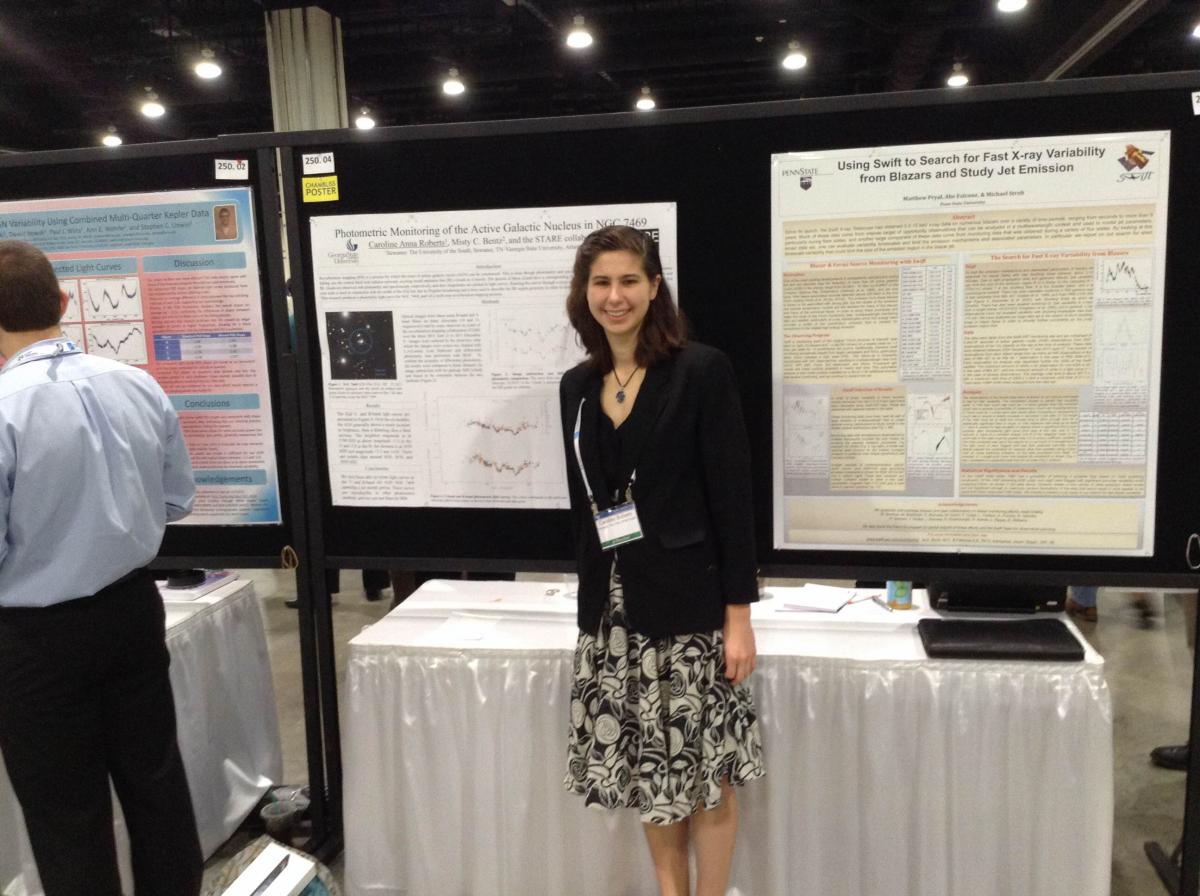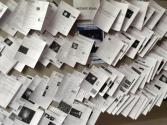223rd American Astronomical Society Meeting
American Astronomical Society Meeting
January 5, 2014 to January 9, 2014
Washington D.C.
Meeting host: By:Caroline Roberts
SPS Chapter:

I am a senior Physics major and SPS member at Sewanee: The University of the South in Tennessee. At the American Astronomical Society meeting I presented a poster on my previous summer’s research at Georgia State University in Atlanta, where I studied reverberation mapping of active galactic nuclei under the guidance of Dr. Misty Bentz, and also attended talks, poster sessions, and myriad other enjoyable activities.
There were many posters given by undergraduates and professionals in the poster sessions at the meeting. My poster detailed one of the processes by which black hole masses are determined. It explained how we obtained our astronomical data, and by what means we reduced and processed the images we used. It also presented light curves for our target active galactic nuclei (AGN), NGC 7469, over a period of six months. My poster was visited by interested individuals, a poster judge for the Chambliss Award competition, faculty and staff from graduate schools I had applied to, and friends from past summer internships. I was also able to share my research with the public and with students at posters near my own.
Upstairs in smaller conference rooms there were contributed oral sessions, each having multiple five-minute talks on topics such as the solar system, the interstellar medium, and exoplanets, just to name a few. Also at the meeting there were amateur talks (talks for amateur astronomers and the public), town hall meetings, press conferences, and career sessions. I particular enjoyed attending a James Webb Space Telescope and Hubble Space Telescope Town Hall and the AAS Working Group on LGBTIQ Equality (WGLE) Town Hall, the former updating attendees on the status of the two missions and the second promoting LGBT equality in the astronomy research community.
In addition to attending poster and contributed oral sessions, the most popular way to learn about new research at the AAS Meeting was to attend plenary sessions. These featured invited talks by scientists who are extremely well-known in their fields, and almost all of the conference attendees come out to hear them. In addition to many other plenary sessions, I attended the Henry Norris Russell Lecture, “New Developments in Galactic Archaeology”, which was presented by Dr. Kenneth C. Freeman of the Australian National University. This lectureship is the highest honor the AAS bestows.
Dr. Freeman chemically studies stars in the galactic disk that have been disrupted from the clusters where they were located in the past, and how the stars separated from the cluster. This study of galactic evolution is called chemical tagging. I had the opportunity to interview Dr. Freeman after his lecture and to ask his advice to undergraduate students. He suggests that in our careers as undergrads, we use as much real data as possible, learn as much coding as possible, do as much research as we can, and take as many math classes as we can. “Relating the math to physics can be tricky, but it’s well worth the effort. So many physics problems are solved by talking with mathematicians who care about science,” Dr. Freeman said.
A highlight of the AAS meeting was a plenary session given by Dr. Neil deGrasse Tyson of the American Museum of Natural History. He presented a talk entitled “Tales from the Twitterverse, and Other Media Excurisons,” which was a fun, humorous, and empowering talk that promoted public education and the grateful and graceful sharing of research with those not in the astrophysics field. He also promoted the new television show he stars in: “Cosmos: A Space-Time Odyssey”, which is a follow-up to Carl Sagan’s “Cosmos”. It premieres Sunday, March 9, 2014 at 9/8c on Fox.
Thanks to my previous summer advisor Dr. Kenneth Rumstay of Valdosta State University, I attended the AAS Donors Reception, where I was able to interview Dr. Tyson on his advice to undergraduate students. He strongly encouraged us to do things that are hard, such as taking challenging courses, rather than taking the easy way out. He also encouraged us young students to study something because we love it, not because we’re good at it, because when the going gets tough, “It’s that love and not your skill that keeps you in the lab late at night when the work is difficult and the parties look fun.”
The Society of Physics Students hosted an SPS Evening of Undergraduate Science at the meeting. The guest speaker was Dr. Kathryn Flanagan, Deputy Director of the Space Telescope Science Institute (STScI). She spoke about her career trajectory and how it took her to places she’d never imagined, moving from research to team management. Her path involved many trials and seized opportunities, and mostly a lot of hard work. The Evening of Undergraduate Science also had refreshments and poster boards, where students could tack up the posters they were presenting in the larger poster hall and practice their presentations. This encouraged networking and conversation among the undergraduates.
The conference also offered many other fun outlets, such as an open mic night where people performed talents of all sorts, and a star party out on the pier near the convention center on the Potomac River.
There was a large poster board at the meeting that was filled with printouts of all of the news articles generated by press coverage of the conference. It was an amazing reminder of how much the public had their eye on the meeting. I was truly honored and excited to attend this conference. Astrophysics has always excited me like no other field, and to be in the presence of others who adore it just as much reignites my love of the subject.
Areas of Alignment: Career Resources: Scientific Categories:
